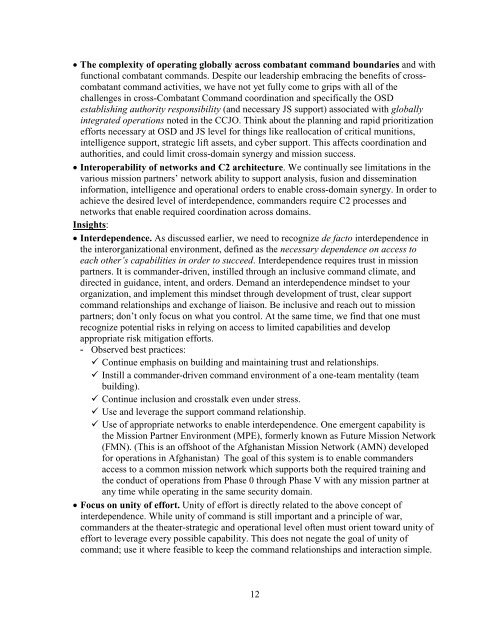Mission Command and Cross-Domain Synergy - Defense ...
Mission Command and Cross-Domain Synergy - Defense ...
Mission Command and Cross-Domain Synergy - Defense ...
- No tags were found...
Create successful ePaper yourself
Turn your PDF publications into a flip-book with our unique Google optimized e-Paper software.
• The complexity of operating globally across combatant comm<strong>and</strong> boundaries <strong>and</strong> withfunctional combatant comm<strong>and</strong>s. Despite our leadership embracing the benefits of crosscombatantcomm<strong>and</strong> activities, we have not yet fully come to grips with all of thechallenges in cross-Combatant <strong>Comm<strong>and</strong></strong> coordination <strong>and</strong> specifically the OSDestablishing authority responsibility (<strong>and</strong> necessary JS support) associated with globallyintegrated operations noted in the CCJO. Think about the planning <strong>and</strong> rapid prioritizationefforts necessary at OSD <strong>and</strong> JS level for things like reallocation of critical munitions,intelligence support, strategic lift assets, <strong>and</strong> cyber support. This affects coordination <strong>and</strong>authorities, <strong>and</strong> could limit cross-domain synergy <strong>and</strong> mission success.• Interoperability of networks <strong>and</strong> C2 architecture. We continually see limitations in thevarious mission partners’ network ability to support analysis, fusion <strong>and</strong> disseminationinformation, intelligence <strong>and</strong> operational orders to enable cross-domain synergy. In order toachieve the desired level of interdependence, comm<strong>and</strong>ers require C2 processes <strong>and</strong>networks that enable required coordination across domains.Insights:• Interdependence. As discussed earlier, we need to recognize de facto interdependence inthe interorganizational environment, defined as the necessary dependence on access toeach other’s capabilities in order to succeed. Interdependence requires trust in missionpartners. It is comm<strong>and</strong>er-driven, instilled through an inclusive comm<strong>and</strong> climate, <strong>and</strong>directed in guidance, intent, <strong>and</strong> orders. Dem<strong>and</strong> an interdependence mindset to yourorganization, <strong>and</strong> implement this mindset through development of trust, clear supportcomm<strong>and</strong> relationships <strong>and</strong> exchange of liaison. Be inclusive <strong>and</strong> reach out to missionpartners; don’t only focus on what you control. At the same time, we find that one mustrecognize potential risks in relying on access to limited capabilities <strong>and</strong> developappropriate risk mitigation efforts.- Observed best practices: Continue emphasis on building <strong>and</strong> maintaining trust <strong>and</strong> relationships. Instill a comm<strong>and</strong>er-driven comm<strong>and</strong> environment of a one-team mentality (teambuilding). Continue inclusion <strong>and</strong> crosstalk even under stress. Use <strong>and</strong> leverage the support comm<strong>and</strong> relationship. Use of appropriate networks to enable interdependence. One emergent capability isthe <strong>Mission</strong> Partner Environment (MPE), formerly known as Future <strong>Mission</strong> Network(FMN). (This is an offshoot of the Afghanistan <strong>Mission</strong> Network (AMN) developedfor operations in Afghanistan) The goal of this system is to enable comm<strong>and</strong>ersaccess to a common mission network which supports both the required training <strong>and</strong>the conduct of operations from Phase 0 through Phase V with any mission partner atany time while operating in the same security domain.• Focus on unity of effort. Unity of effort is directly related to the above concept ofinterdependence. While unity of comm<strong>and</strong> is still important <strong>and</strong> a principle of war,comm<strong>and</strong>ers at the theater-strategic <strong>and</strong> operational level often must orient toward unity ofeffort to leverage every possible capability. This does not negate the goal of unity ofcomm<strong>and</strong>; use it where feasible to keep the comm<strong>and</strong> relationships <strong>and</strong> interaction simple.12
















